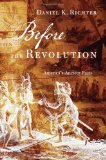History is not a discreet collection of independent events. What happens in one epoch, such as the Victorian Era or the Revolutionary Period, is not divorced from earlier events in the same epoch nor from events in previous epochs. Historical events are not blank slates—rather, there are always traces and artifacts left on the slate from what was writ before. And so with Before the Revolution: America’s Ancient Pasts, by Daniel Richter, it is refreshing to read a historical text that takes these “conditional events” into consideration, leading to perhaps one of the most nuanced and reliable accountings of the Pre-Revolutionary period of American history.
The basic strategy Richter uses in constructing and telling this part of American history is to divide the years 900-1765 CE into rough categories or “layers” of history, semantically labeled “Progenitors,” “Conquistadores,” “Traders,” “Planters,” “Imperialists,” and “Atlanteans.” For example, in the Progenitors time period, from about 900-1500 CE, Richter details the histories of both medieval Europe as well as medieval North America by comparing and contrasting the medieval periods on both continents.
Cultures on both continents were greatly affected by the Medieval Warm Period and the Little Ice Age, and both cultures evolved into stronger agricultural societies dominated by religious and military elites who concentrated power in a harsh top-down model. Constant Indian-against-Indian and European-against-European military aggression was also the main method both cultures used to establish dominance and power. However, the cultures differed in that in Europe, the commercialization and ownership of land, as well as the growth of a strong merchant class within large cities, led to a feudal culture, as rulers needed vast monetary and military resources to enable economic and political growth, thus giving to indentured servitude as a way to secure and stabilize dependable workers necessary for land development and tax/tribute revenues.
With this first layer of history established, in the next layer, Conquistadores, Richter shows how the social, economic, military, and religious concepts of power in both Indian as well as European cultures played into the synergistic relationships that developed between the Indians and the early Europeans coming to North America. Rich economic ties were established between these cultures, but so too did harsh military conflicts develop. These relationships, both supporting and conflicting, were fostered when the early European explorers turned into colonizers in the “Traders” period. Thus, the Progenitors period greatly influenced the Conquistadores period. Richter continues throughout the rest of the book this layered, nuanced pattern of showing Indian as well as English and European perspectives, influenced by a rich layered history between the two cultures.
How does Before the Revolution: America’s Ancient Pasts differ from, say, A Kingdom Strange, by James Horn? Superficially, the books are different in that A Kingdom Strange covers a narrow slice of time and scope, focusing primarily on the colonization efforts of North America by the English during the time period of about 1500-1700 CE. Before the Revolution: America’s Ancient Pasts, as previously mentioned, covers a much broader swath of time and includes Indian as well as European perspectives. The intent of each book is different in that the Horn writes a close, almost character-driven account of the English who made those initial colonization attempts, whereas Richter takes a step back to consider, with a history-driven account, the American Indian, English, and Continental Europe perspectives and motivations.
Thus, it becomes clear that unpacking the causes of a particular historical event becomes very difficult due to a deep and complex prior history. Newspaper headlines often desire to have clear “villains” and “heroes” regarding historical events, but as is demonstrated in Before the Revolution: America’s Ancient Pasts, as in real life, historical events are rarely so easily categorized and labeled, due to webs of economical, religious, military, and cultural relationships between cultures that were created over long periods of time.
